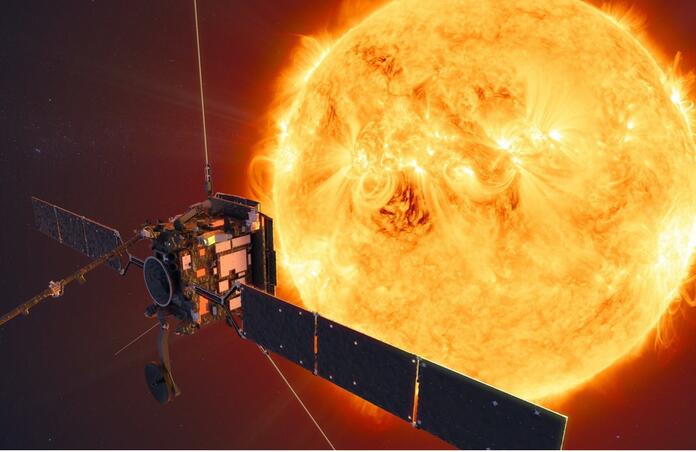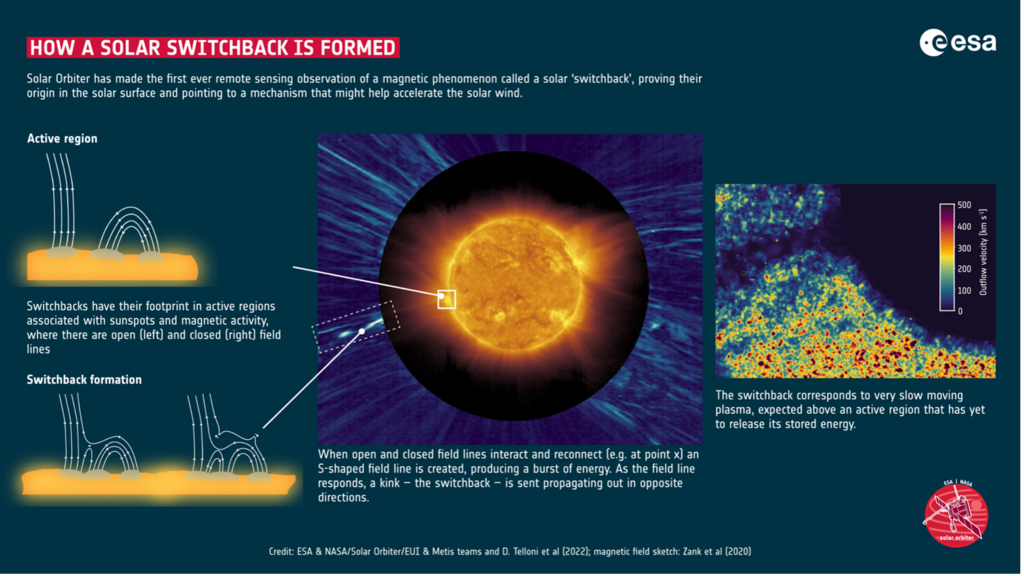Solar Orbiter Finds Compelling Clues for Solving Magnetic Switchback Theory

ESA/NASAs Solar Orbiter has made its first closest pass of the sun, revealing clues to the origin of mysterious magnetic switchbacks and how the mechanism of their formation could help accelerate the solar wind.

Solar switchbacks are the sudden and large deflections of the solar winds magnetic field. This interesting phenomenon has been detected by a number of spacecrafts that have flown through these regions, notably in the mid 1970s when the German-US Helios 1 and 2 spacecrafts picked up the reversal in magnetic field. However, these switchbacks were seemingly abrupt and temporary, lasting a few seconds to hours before returning to its original direction. Additionally, these magnetic structures were also probed at much greater distances from the sun by the Ulysses spacecraft in the late 1990s – Ulysses operated beyond Earths’ orbit, whereas Helios made its closest pass to the sun within a third of the Earth-sun distance.
However, the number of detected switchbacks grew highly when NASA introduced the Parker Solar Probe in 2018. This lead astronomers to believe that magnetic switchbacks are more common closer to the suns’ surface, and that they are caused by S-shaped kinks in the magnetic field. This was only a theory though, since the sudden reversals had not been directly observed up to this point due to the lack of cameras on board the spacecrafts.
The Solar Orbiter made that theory a reality, since it has made the first ever remote sensing observation consistent with a solar switchback. The probe was built to take the closest images of the sun and study its magnetic field, equipped with two types of sun observing sensors- direct imaging instruments and those that measure properties of the stars’ surrounding environment. In March earlier this year, one day away from making its closest solar approach an observation was taken by Metis, the Solar Orbiters coronagraph. Metis blocks the glare from the suns’ surface and takes pictures of the corona. The image produced displayed a distorted S-shaped kink in the coronal plasma, which got astronomers thinking: could this be a solar switchback?
It was indeed! After comparing the Metis image to one taken by Solar Orbiters Extreme Ultraviolet Imager (EUI) instrument, it was found that the switchback was taking place above an active region- a sunspot, catalogued as AR 12972, which is a cooler area where the magnetic field is twisted and dense. Upon further analysis of the data, it was discovered that the plasma speed above the region was very slow, as to be expected from an active region that has not yet released its stored energy.

The observation reminded Daniele Telloni, National Institute for Astrophysics- Astrophysical observatory of Torino, Italy of a generating switchback mechanism proposed by Prof. Gary Zank, University of Alabama, USA. The theory focused on the way different magnetic regions near the solar surface interact with each other. Closer to the surface, there are open and closed magnetic field lines, especially above active regions. Open field lines extend from the sun and connect with the interplanetary magnetic field of the solar system, allowing plasma to freely flow hence producing fast solar winds. On the other hand, closed field lines arch up into the solar atmosphere before curving round and disappearing back into the sun. Only a small amount of plasma can escape to space in this situation, resulting in slow solar wind speeds. From this mechanism combined with the observations, it was proven that switchbacks occur when there is an interaction between a region of open and a region of closed field lines. As the field lines are pushed together, they can reconnect in more stable configurations resulting in the release of energy in the form of S-shaped disturbances which travel to space and are recorded as switchbacks.
This is a vital step forward for solar physicists in their understanding of how solar wind is accelerated and heated away from the sun- when spacecrafts fly through these regions, they often register a localised acceleration of the solar wind. The next step for the team will be to have a spacecraft fly through the switchback region and be able to see what’s happening on the suns’ surface. The probe will make its next close pass to the sun on the 13th of October, and perhaps it will reveal even more into the mystery of solar switchbacks.
--
Cover image: ESA/ATG Medialab
Image credits:
- ESA & NASA/Solar Orbiter/EUI & Metris teams and D. Telloni et al (2022); magnetic field sketch: Zank et al (2020)
- ESA
- Zank et al (2020)
